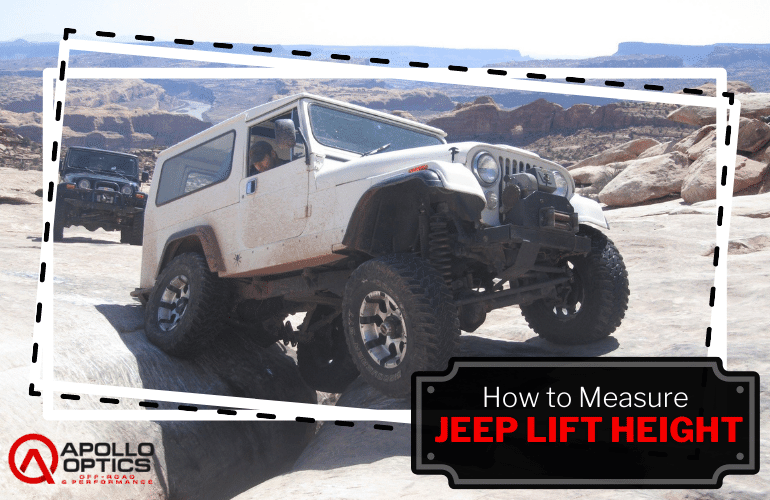 In the world of Jeep customization, there are perhaps no modifications
more popular than the installation of a lift kit. In fact, it is quite common
to see just as many Jeep Wranglers on the road that are lifted as those that
are not. Jeep lifts have grown immensely in popularity over the past decade and
represent one of the largest sectors of the aftermarket component industry.
In the world of Jeep customization, there are perhaps no modifications
more popular than the installation of a lift kit. In fact, it is quite common
to see just as many Jeep Wranglers on the road that are lifted as those that
are not. Jeep lifts have grown immensely in popularity over the past decade and
represent one of the largest sectors of the aftermarket component industry.
One of the most appreciated characteristics of a lift is that the installation of such kits allows consumers to transform their Jeep to meet their personal preferences. Jeep lift kits are available in a wide range of sizes and configurations, quite literally allowing one to take their Wrangler or Cherokee to new heights.
Why Lift A Jeep?
The reasons for lifting a Jeep are numerous and vary from one consumer to the next. However, the following are among the top reasons for outfitting a Jeep with a custom lift kit.
Fitment for Larger Tires
When attempting to upgrade to the use of larger than stock tires, clearance can quickly become an issue. At stock ride height, one can only get away with a certain amount of upsizing without creating fender and steering linkage interference. While the installation of fender flares and wheel spacers can create a minor increase in clearance, such mods will only allow for modest increases in tire size.
The installation of a quality lift kit serves as the “fix-all” for this tire sizing conundrum. By elevating your Jeep’s overall ride height, you can make much more significant increases in tire size without suffering from scrubbing and interference as a result.
Increased Ground Clearance
A Jeep is naturally adept at handling all that the trail throws its way. However, even a Jeep has its limits when encountering the most substantial of obstacles, especially when riding at stock height. In fact, almost every avid off-road enthusiast has been left wishing that they had a little additional ground clearance to work with on one occasion or another. Without sufficient clearance, deep ditch lines and boulder-strewn trails can spell the end of the line, with a Jeep’s skid plate, transfer case, and driveshaft often bearing the brunt of the abuse.
By lifting your Jeep, you can gain the additional ground clearance that is needed to conquer all obstacles that you might encounter. Moderately-sized boulders and other trail debris can then be navigated over or across, when they previously would have proven insurmountable.
Cosmetic Appeal
While there is certainly nothing wrong with the looks of a Jeep’s stock stance or ride height, there is always room for improvement. The look of a lifted Jeep is unmistakably striking and often commands a glance or two from intrigued onlookers upon every trip down the road. One can quite simply provide their Jeep with a level of innate personality with the installation of a well-chosen, heavy-duty lift kit.
The addition of a lift kit also opens the door to a number of subsequent modifications, many of which have the potential to further enhance your Jeep’s looks. Custom aftermarket wheels and tires can now be installed, and sufficient clearance is created to validate the use of nearly any aftermarket bumper or running boards.
Different Types of Lift Kits
Once you have decided that a lift kit is for you, the next order of business is to determine the exact type of lift kit to purchase. Lifts can differ substantially from one kit to the next regarding their composition and the exact results that one can expect. Lift kits range from modest in height to extreme in form, with plenty of available options in between.
Lift kits can even differ substantially in composition and size from one manufacturer to the next. Some of the most popular of these manufacturers include Rough Country, ReadyLift, OME, Rancho, and Teraflex.
The following are the most prevalent types of Jeep lifts, as well as what one should expect from the purchase of each.
Leveling Kits and Body Lifts
Leveling kits have continued to increase in popularity over the past several years, in large part because of the clean appearance which they provide. Much like their name would suggest, leveling kits “level” a vehicle’s stance, eliminating discrepancies between front and rear ride heights. Kits of this nature slightly raise the front of a vehicle, thereby minimizing “rake.”
While leveling kits do indeed provide a Jeep with a special degree of cosmetic appeal, they typically provide little in the way of actual lift. One should not expect anything more than a 2”-3” increase in ride height with the installation of a leveling kit.
Body Lifts are another option for those who are looking for a rather reserved increase in ride height. This type of lift utilizes rubber spacer pucks to separate a vehicle’s frame and body. Body lifts are best suited for those that simply wish to achieve a lifted look without going to the trouble and expense of installing a full-on suspension lift. However, from a functionality standpoint, no additional travel is created with a simple body lift since a vehicle’s frame and wheels retain the same spacing.
Realistically, the installation of a body lift is a rather cost-efficient way of gaining an additional 1”-2” of ride height, without being required to replace additional components. In the majority of cases, a height increase of greater than 3” can lead to component fitment issues.
Suspension Lifts
If you wish to maximize your Jeep’s total lift height, then a suspension lift is the way to go. These kits are designed to create greater distance between a Jeep’s suspension and frame, thereby serving in a functional context rather than solely as a cosmetic upgrade. Suspension lift kits come in a number of heights and configurations, allowing consumers to select that which best suits their particular needs.
Kits of this nature can typically be found in a 2.5-inch lift to 6-inch lift height designations and include a wealth of individual components such as coil springs, extended control arms, sway bar links, front track bars, bump stops, and bushings. When installed properly, a suspension lift provides a comprehensive solution to your ride height-related needs.
On the downside, the installation of suspension lift kits can be rather involved and often require a bit of mechanical aptitude to successfully fit in place. Additionally, any suspension lift over 2.5-inches in height will require the use of a slip yoke eliminator on all YJ and TJ models as well as a CV driveshaft for vibration prevention. Larger suspension lift kits are also known to negate a Jeep’s factory ride comfort, at least to a certain degree.
Coil lifts, in many regards, are considered to be a form of suspension lift. However, Coil lifts are typically not as comprehensive as other suspension lifts in relation to their array of included components. These kits generally include aftermarket springs, which are substantially larger than the OEM stock springs previously fitted to a vehicle. The vast majority of these kits come with custom shocks as well.
Differences Between Long and Short Arm Kits
Full suspension style lifts are often divided into one of two sub-categories, referred to as long arm and short arm kits. These two types of suspension lifts differ from one another in their composition and the way that they attach to a Jeep’s chassis. Prior to purchasing a suspension kit, it is important to understand the differences between each of these two lift styles and what each means for your Jeep JK Wrangler, JL Wrangler, TJ Wrangler, or YJ Wrangler’s performance.
The terms “short arm” or “long arm” refer to the style of control arm used within a particular suspension style lift kit. Short arm kits retain the use of a Jeep’s factory control arm mounts, while long arm kits call for the complete removal of these mounts to make way for the installation of more substantial replacement mounts.
The following is a more in-depth look at the pros and cons associated with each style of suspension lift.
Short Arm Kit
Short arm suspension kits remain popular, largely because of their lower cost and relative ease of installation. A kit of this design typically includes new bump stops, brake line extensions, coils, shocks, track bars, and sway bars.
While short arm lifts can be purchased at heights ranging from 3.5”-6”, lifts on the shorter end of this spectrum are known to provide superior ride quality and are often substantially more affordable by design.
Long Arm Kit
Long arm suspension kits tend to be the lift option of choice for many in search of a 4” or greater increase in height. A kit of this design requires a substantial amount of work to install, including a rather extensive amount of fabrication effort. There is also more expenditure involved in purchasing a long arm kit than in the case of a short arm kit.
Once installed, long arm kits are often cited as being more manageable, especially at taller heights, than short arm kits of the same size. Much of this stems from the fact that a Jeep’s actual control arm angle is modified with the installation of a long arm suspension kit.
How to Measure a Jeep Lift Height
Of course, it is quite simple to recite the size and specs associated with a particular lift kit if you were the one to have purchased it. However, sometimes a Jeep is purchased second hand, with a lift kit already installed. In cases such as this, a Jeep owner needs to know the actual height of their lift in order to make informed buying decisions in the future, especially regarding acceptable wheel and tire sizes.
Luckily, there is a definitive way of taking such measurements which allows Jeep owners to correctly size their particular lift.
TJ Wrangler Lift Measurement
There are few Jeep lift heights that are as easy to measure as those of the TJ Wrangler. This is because all TJ models throughout the years carried identical stock spring sizes. All TJ Wranglers featured 12-inch front springs and 8-inch rear springs. Therefore, actual spring sizes can be taken from a TJ Wrangler and compared to these stock measurements in order to determine the difference between these two figures.
By subtracting the TJ’s stock measurements from the measurements of springs currently in use, you will be provided with the height of your Jeep’s suspension lift. Additionally, the presence of a body lift can be quickly determined by the observance of coil spring spacers. Any spacers that are present can be measured for reference.
JK Wrangler Lift Measurement
The JK Wrangler has utilized multiple stock spring heights throughout its production run, thereby complicating the matter of lift height measurement. However, savvy Jeep enthusiasts have discovered a universal procedure for taking such reference measurements based upon curb height.
To measure a JK Wrangler’s curb height, begin by ensuring that your fuel tank is full and all fluids are topped off. Next, pull to a level location, place your Jeep in 2WD, and rock up and down on the Jeep’s front end to ensure that all suspension components are resting in their natural positions.
Curb height measurements are then taken for both the front axle and rear axle. This measurement is taken from a Jeep’s jounce bumper cap to the inner spring seat’s top lip on the corresponding axle. This process is repeated for both axles and is then compared to the stock heights for the particular JK Wrangler that is being measured.

